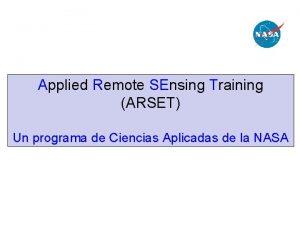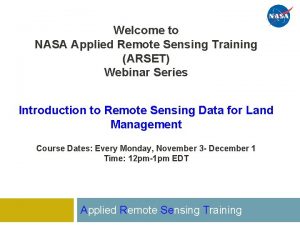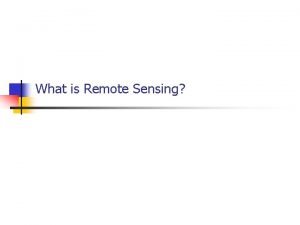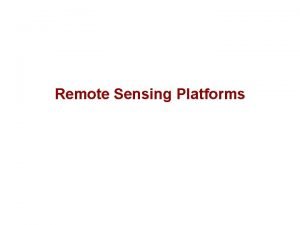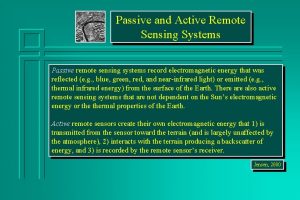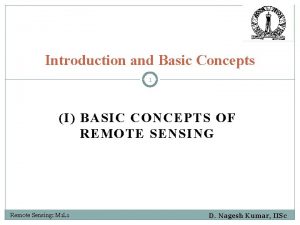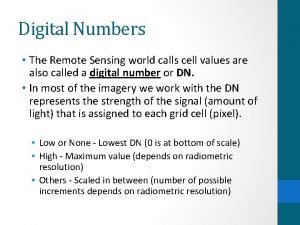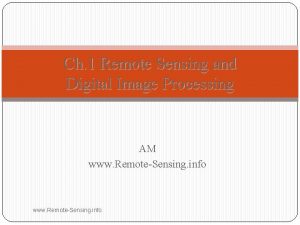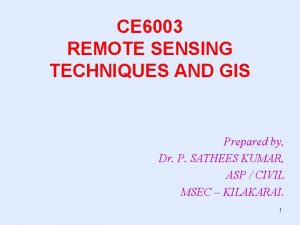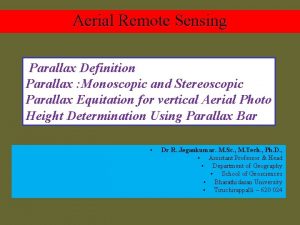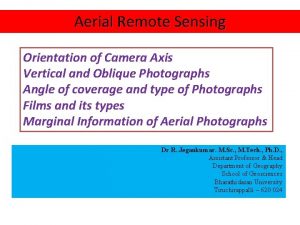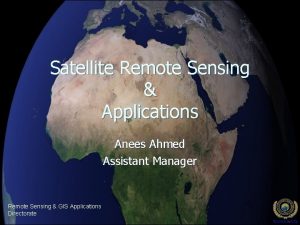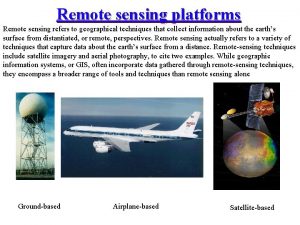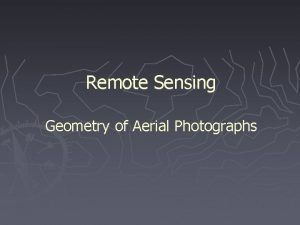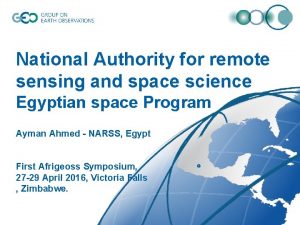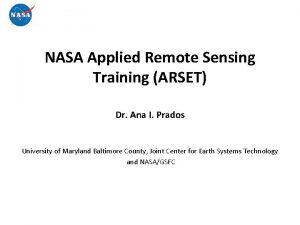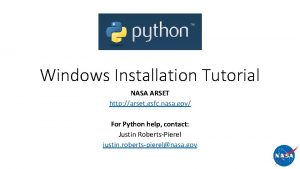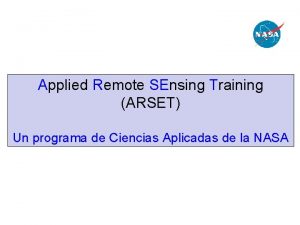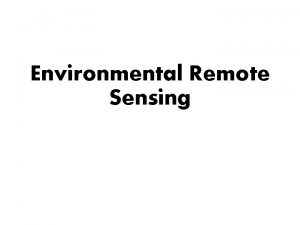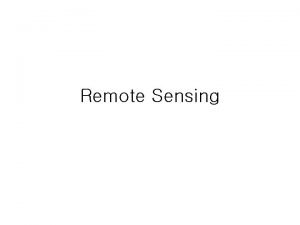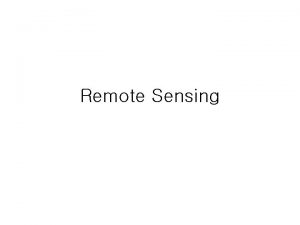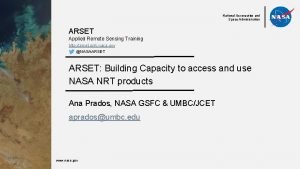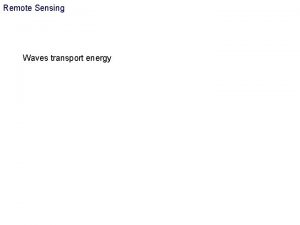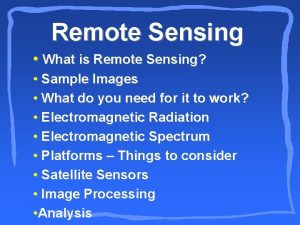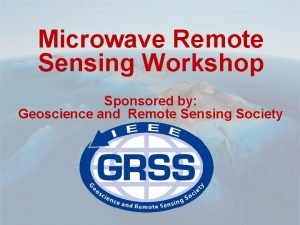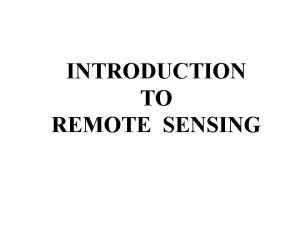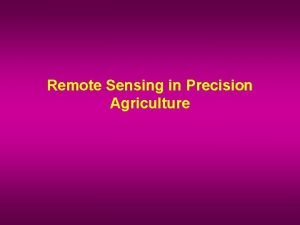NASA Applied Remote Sensing Training ARSET Ana I
















- Slides: 16

NASA Applied Remote Sensing Training (ARSET) Ana I. Prados 1, Pawan Gupta 2, and Brock Blevins 1 (1)University of Maryland Baltimore County, Joint Center for Earth Systems Technology/NASA/GSFC (2) USRA/NASA GSFC

About the ARSET Program ▪ Part of NASA’s Applied Sciences Program/Capacity Building Program ▪ Since 2008 ▪ 15 Team members (12 scientists) Pawan Gupta: ARSET Air Quality Lead ▪ Located at 3 NASA centers: ▪ Goddard Space Flight Center (core team) ▪ Jet Propulsion Laboratory ▪ Ames Research Center

Applied Remote Sensing Training (ARSET) http: //arset. gsfc. nasa. gov GOAL: Increase utilization of NASA observational and model data for decisionsupport through training activities for environmental professionals. Online training: Live and recorded, 4 -6 weeks in length. Include demos on data access, GIS and NASA webtools In person training: In a computer lab, 2 - 4 days, partnering with 1 or more stakeholders. Train the Trainers: Learn how to design and conduct your own remote sensing training course

ARSET Training: Thematic Areas Air Quality Water Resources and Flood Monitoring Pollution over China Satellite derived precipitation Land Management and Wildfires Smoke LAND COVER Land Cover

Gradual Learning Approach Online Training Basic Training Webinars Hands-on Assumes no prior knowledge of RS Advanced Training Hands-on Webinar course generally required Focused on a specific application/problem/Data: e. g. dust or smoke monitoring in for a specific region Coming soon: hybrid trainings/ advanced webinars (2016) In-Person Training

Training Scope: Data, Tools, and Applications • MODIS • OMI • CALIPSO • MISR • VIIRS • TRMM

ARSET: 2008 -2015 4000+ End-users 1400+ Organizations 130 Countries 53 Trainings Number of participating organizations per country or US State for: Air Quality, Water, Flood, and Land/Wildfires management trainings

ARSET Program Participation: 2012 -2015 Air Quality Training Participation since 2008 1300+

Air Quality Training at EPA RTP September 29 - October 1, 2014 • Objective: Build basic skills on image access and interpretation. Initiate conversations for additional webinar courses for EPA regions. B • Training Partner: The EPA RSIG team presented their tool • 30 Participants from 3 EPA Offices: • Office of Air Quality Planning & Standards • Office of Research and Development • Office of Environmental Information • Products and Tools Presented: • Satellite Aerosols: AEROSTAT, HDFLook, • IDEA, GIOVANNI, LAADSWEB, WORLDVIEW, RSIG Satellite Trace Gas: OMI SO 2, NO 2, AIRS and MOPITT CO, WHIPS • Outcomes: • • All participants indicated the workshop either met or exceeded their expectations (62% and 38% respectively) 41% would like to participate in advanced webinars in the future. C

Webinar: NASA Earth Observations and Tools for Air Quality Applications in South East Asia: April 1 - April 29, 2015 ● Objective: To increase knowledge of NASA and NOAA air quality data products and their application in South East Asia. Course included live demonstrations on data access and analysis. ● Training Partners: Adam Voiland (Earth Observatory), and AQICN (AQ network). ● Participation: 166 participants, 120 organizations, 31 countries, 20 states ● International and National Organizations: Department of Environment Regulation, Western Australia; National Institute of Aeronautics and Space, Indonesia; ICIMOD; Environmental Management Bureau, Manila, Philippines; National Environment Agency, Singapore; Thai Meteorological Department, Thailand; Mientrung Institute Scientific Research, Vietnam ● US Federal and State agencies: U. S. Global Change Research Program, California Air Resources Board ● Outcomes: Most attendees (75%) indicated that the webinar met their expectations while 25% indicated that the webinar exceeded their expectations; 61% expressed interest in more advanced online webinars. Course over-subscribed +350 registrants B C Countries who participated in the webinar

Air Quality Training for Stakeholders in the Southeastern US September 1 -3, 2015, Atlanta, GA The workshop taught attendees how to apply NASA resources to air quality forecasting, smoke/fire, and PM 2. 5 monitoring. It built basic skills on image, level 2, and level 3 data access, reading, analysis, and interpretation. Survey Results (70% response rate) • 95% of respondents indicated the workshop either met (68%) or exceeded expectations (26%) • One of the most useful skills learned was the use of Python scripts for reading and plotting NASA data. 30 participants from agencies including: • Georgian Environmental Protection Division • Bureau of Ocean Energy Management • Georgia Dept. of Natural Resources • Florida Dept. of Environmental Protection • Chattanooga-Hamilton County Air Pollution Control Bureau • EPA Region 4 Office • SC Dept. of Health and Environmental Control • National Park Services & U. S. Forest Services B C Participant feedback: “The training is important for understanding and documenting exceptional pollution events- especially dust and fire events. It is very important for the monitoring community to understand the satellite pictures and models for use in our everyday work, too. ”

Current Tools For End-user Needs Assessment ARSET Training Course Application Forms Interviews with Key Informants Informal feedback during webinar Q/A period Survey 1: at the completion of each training Surveys 2: 6 months post training. To measure impact and changes in NASA data use. • Ad Hoc interviews to collect “success stories” • Air Quality Working Group (begins Nov. 2015). • • • 12

Respondents’ Opinions about ARSET Air Quality Trainings: Hands-on Courses • 100% of U. S. respondents & 95% of non-U. S Respondents agreed or strongly agreed: – The ARSET training increased my knowledge of remote sensing data products. • 89% of U. S. respondents & 82% of non-U. S Respondents agreed or strongly agreed: – The ARSET training increased my ability to access remote sensing data products. • 55% of U. S. respondents & 54% of non-U. S Respondents agreed or strongly agreed: – The ARSET training improved my ability to make decisions regarding air quality.

Changes in utilization of remote sensing data after participation in ARSET training: Type of Air Quality Application % reporting some change in use Changes in utilization of remote sensing data for Air 84% U. S. respondents 75% non-U. S. respondents Quality Regulation & Policy Applications after State Implementation Plans 33% U. S. respondents non-U. S. training: respondents participation in 57%ARSET Exceptional Events Policy recommendations 48% U. S. respondents 45% non-U. S. respondents Air Quality Research 75% U. S. respondents 89% non-U. S. respondents Assimilation into air quality models 35% U. S. respondents 33% non-U. S. respondents Data for support of air quality forecasting 76% U. S. respondents 57% non-U. S. respondents Health issues 41% U. S. respondents 31% non-U. S. respondents Air quality monitoring 66% U. S. respondents 65% non-U. S. respondents Percentages are based on number of total respondents for whom the task was applicable

New for 2015 NASA-ARSET Air Quality Working Group • Goal: Facilitate the exchange information from end-users (via ARSET) to NASA and vice-versa. • Comprised of NASA PIs, Data Centers and the ARSET team (20 members). • First meeting: November 2015 • Formal report will be submitted to NASA HQ in 2016.

Want to learn more ? Visit http: //arset. gsfc. nasa. gov/
 Applied remote sensing training program
Applied remote sensing training program Nasa arset certificate
Nasa arset certificate Limitations of remote sensing
Limitations of remote sensing Remote sensing platforms
Remote sensing platforms Active passive remote sensing
Active passive remote sensing Ideal remote sensing system
Ideal remote sensing system Digital number in remote sensing
Digital number in remote sensing Limitations of remote sensing
Limitations of remote sensing Idealized remote sensing system
Idealized remote sensing system Graduated symbol map definition ap human geography
Graduated symbol map definition ap human geography Remote sensing ap human geo
Remote sensing ap human geo Parallax in aerial photography
Parallax in aerial photography Strip camera in remote sensing
Strip camera in remote sensing Remote sensing image
Remote sensing image Ifov and fov in remote sensing
Ifov and fov in remote sensing Geometry of vertical aerial photograph
Geometry of vertical aerial photograph National authority for remote sensing and space sciences
National authority for remote sensing and space sciences
